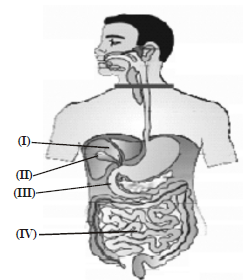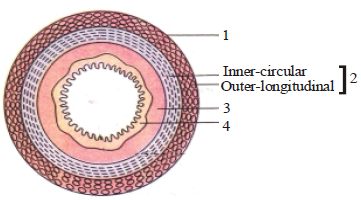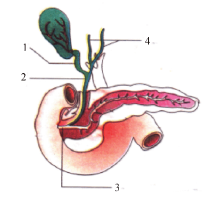Please see Chapter 16 Digestion and Absorption Exam Questions Class 11 Biology below. These important questions with solutions have been prepared based on the latest examination guidelines and syllabus issued by CBSE, NCERT, and KVS. We have provided Class 11 Biology Exam Questions and answers for all chapters in your NCERT Book for Class 11 Biology. These solved problems for The Living World in Class 11 Biology will help you to score more marks in upcoming examinations.
Exam Questions Chapter 16 Digestion and Absorption Class 11 Biology
Objective Questions
Question. Mammalian teeth are
(a) acrodont
(b) homodont
(c) thecodont
(d) polyphyodont
Answer
C
Question. The function of tongue is to
(a) grind and crush the food.
(b) position food for swallowing.
(c) add enzymes and moisture to the food.
(d) protect the opening of the pharynx during swallowing.
Answer
B
Question. The innermost layer of the digestive tract is the
(a) serosa membrane
(b) mucosa membrane
(c) submucosa membrane
(d) lumen
Answer
B
Question. Crypts of lieberkuhn are present in
(a) intestine
(b) stomach
(c) oesophagus
(d) all of these
Answer
A
Question. Which of the following does not produce any digestive enzyme ?
(a) Acini of pancreas
(b) Liver
(c) Stomach
(d) Duodenum
Answer
B
Question. Brunner’s glands are found in
(a) submucosa of stomach
(b) wall of rectum
(c) submucosa of duodenum
(d) mucosa of ileum
Answer
C
Question. Where does bile go after it leaves the gall bladder?
(a) Duodenum
(b) Jejunum
(c) Ileum
(d) Caecum
Answer
A
Question. The common bile duct in human is formed by the joining of
(a) pancreatic duct and bile duct.
(b) cystic duct and hepatic duct.
(c) cystic duct and pancreatic duct.
(d) hepatic duct and pancreatic duct.
Answer
B
Question. Digestive enzymes responsible for breaking down disaccharides includes
(a) pepsin, trypsin and trypsinogen.
(b) amylase, pepsin, and lipase.
(c) sucrase, lactase, and maltase.
(d) pepsin, trypsin, and chymotrypsin.
Answer
C
Question. pH of saliva is
(a) 6.5
(b) 8
(c) 7
(d) 9.5
Answer
A
Question. Which digestive organ mechanically and chemically transforms a food bolus into chyme?
(a) Oesophagus
(b) Stomach
(c) Small intestine
(d) Large intestine
Answer
B
Question. Succus entericus is a term used for
(a) the junction of ileum and colon
(b) inflammation of intestine
(c) vermiform appendix
(d) digestive juice of intestine
Answer
D
Question. The protein coated, water soluble fat globules are called
(a) chylomicrons
(b) micelles
(c) chyle
(d) monoglycerides
Answer
A
Question. Pancreatic juice helps in the digestion of
(a) proteins and fats
(b) proteins and carbohydrates
(c) fats and carbohydrates
(d) proteins, fats and carbohydrates
Answer
D
Question. Enzyme trypsinogen is changed to trypsin by
(a) gastrin
(b) enteropeptidase
(c) enterogastrone
(d) secretin
Answer
B
Statement Type Questions
Question. Which of the following statements is correct regarding chylomicrons ?
(a) They are undigested proteins.
(b) They are undigested carbohydrates.
(c) They are fat droplets coated with phospholipids.
(d) They are fat droplets coated with glycerol and proteins.
Answer
D
Question. Which of the following statement is incorrect ?
(a) Brunner’s glands are submucosal.
(b) Rugae are the irregular folds of inner gastric mucosa.
(c) Glisson’s capsule is the connective tissue sheath of hepatic lobule.
(d) Mesothelium or serosa lies in close proximity of the sub-mucosa.
Answer
D
Question. What is common among amylase, renin and trypsin?
(a) All are proteins.
(b) All are proteolytic enzymes.
(c) Produced in stomach.
(d) Act at pH lower than 7.
Answer
A
Question. Which one of the following statements is true regarding digestion and absorption of food in humans?
(a) About 60% of starch is hydrolysed by salivary amylase in our mouth.
(b) Oxyntic cells in our stomach secrete the proenzyme pepsinogen.
(c) Fructose and amino acids are absorbed through intestinal mucosa with the help of carrier ions like Na+.
(d) Chylomicrons are small lipoprotein particles that are transported from intestine into blood capillaries.
Answer
C
Question. Which of the following statements is incorrect?
(a) Saliva lubricates the food.
(b) Tongue helps in chewing of food.
(c) Salivary glands have protein digesting enzymes.
(d) Bile does not contain any digestive enzymes.
Answer
C
Question. Which of the following statements are true regarding human digestive system?
(i) Food is not digested in the gullet.
(ii) There is no digestive juice in the mouth.
(iii) Food is digested completely in the stomach.
(iv) The large intestine is shorter than the small intestine.
(v) Inside the large intestine, most of the water from the undigested food is absorbed by the body.
(a) (i) and (ii) only
(b) (iii) and (v) only
(c) (i), (iv) and (v) only
(d) (ii), (iii) and (iv) only
Answer
C
Question. Which of the following statements is correct regarding absorption of fatty acids?
(a) It is absorbed into the bloodstream at the small intestine.
(b) It is absorbed into the lymph vessels at the small intestine.
(c) It is absorbed into the lymph vessels from the blood stream.
(d) It is absorbed into the bloodstream at the large intestine.
Answer
B
Matching Type Questions
Question. Choose the correct matching pair.
(a) Renin – Protein
(b) Trypsin – Starch
(c) Invertase – Sucrose
(d) Amylase – Lactose
Answer
C
Question. Select the correct match of the digested products in humans with their absorption site and mechanism.
(a) Fructose, Na+ – Small intestine, passive absorption
(b) Glycerol, fatty acids – Duodenum, move as chylomicrons
(c) Cholesterol, maltose – Large intestine, active absorption
(d) Glycine, glucose – Small intestine, active absorption
Answer
D
Question. Which one of the following is the correct matching of the site of action of the given substrate, the enzyme acting upon it and the end product?
| Secretion | Source | Target | Action | |
| (a) | Enterokinase | Duodenum | Gall bladder | Release of bile juice |
| (b) | Gastrin | Stomach lining | Oxyntic cells | Production of HCl |
| (c) | Salivary amylase | Salivary gland | Mouth | Breakdown of starch into maltose |
| (d) | Rennin | Saliva | Small intestine | Emulsification of fats |
Answer
C
Question. The given pair represent substrate-enzyme pair. Which of the following pair is (are) correct?
A. Maltose – Lactase
B. Protein – Pepsin
C. Carbohydrate – Lipase
D. Casein – Renin
(a) A and B only
(b) B and C only
(c) A and D only
(d) B and D only
Answer
D
Question. Which of the following monomers are produced, when lipids are broken down by lipase?
A. Nucleotides
B. Amino acids
C. Glycerol
D. Fatty acids
(a) A and C only
(b) C and D only
(c) C only
(d) D only
Answer
B
Question. Match the following organic molecules given in column I with their correct description given in column II and then choose the correct option.
| Column-I (Organic molecules) | Column-II (Description) |
| A. Carbohydrates | I. It is made of fatty acids and glycerol |
| B. Proteins | II. It is mostly ingested in the form of starch |
| C. Nucleic acids | III. It is built of long chains of amino acids |
| D. Lipids | IV. It is made of ribose or deoxyribose sugars and nitrogenous bases. |
(a) A – I; B – II; C – III; D – IV
(b) A – IV; B – I; C – II; D – III
(c) A – III; B – IV; C – I; D – II
(d) A – II; B – III; C – IV; D – I
Answer
D
Diagram Type Questions
Question. The diagram given below shows the human digestive system. Few structures are marked as I, II, III and IV. Which region of the human digestive system releases bile juice?

(a) I
(b) II
(c) III
(d) IV
Answer
A
Question. Refer the given diagram of digestive system to answer the question.

Which of the following is associated with the structure marked as “X”?
(a) It is a small blind sac which hosts some symbiotic microorganisms.
(b) The undigested, unabsorbed substances enter into this structure through ileo-ceacal valve.
(c) It helps in mechanical churning and chemical digestion of food.
(d) Both (a) and (c)
Answer
C
Directions for Questions : Refer the given figure and answer the questions. This figure shows the diagrammatic representation of T.S of gut with few structures marked as 1, 2,3 and 4

Question. Which of the following part is made up of a thin mesothelium with some connective tissue?
(a) 1
(b) 2
(c) 3
(d) 4
Answer
A
Directions for Questions : The given diagram shows the duct systems of liver, gall bladder and pancreas in which few structures are marked as 1.2.3 and 4. On the basis of this figure answer the questions.

Question. Which two ducts are responsible for the formation of a duct that carry bile from the gall bladder and conduct it into the first section of the small intestine?
(a) 1 and 2
(b) 2 and 3
(c) 3 and 4
(d) 4 and 1
Answer
D
Critical Thinking Type Questions
Question. What happens to the food when it enters from oesophagus to stomach?
(a) Food mixes with juices and protein digestion starts.
(b) Food mixes with juices and carbohydrate digestion starts.
(c) Food quickly moves into small intestine.
(d) Food quickly moves into large intestine.
Answer
A
Question. Which digestive processes takes place in the mouth?
(a) Both chemical and physical digestion.
(b) Chemical digestion only.
(c) Physical digestion only.
(d) Neither chemical nor physical digestion.
Answer
A
Question. Which part is infected when a person is suffering from diarrhoea ?
(a) Small intenstine
(b) Large intestine
(c) Stomach
(d) None of these
Answer
B
Question. If the epiglottis does not function correctly, then what will happen to the human being ?
(a) One might congest.
(b) Peristalsis will discontinue.
(c) Acid reflux disease will damage the oesophagus.
(d) Swallowing will be difficult or impossible.
Answer
A
Question. If the large intestine becomes irritated and peristalsis increases then which of the following will result?
(a) Indigestion
(b) Diarrhoea
(c) Constipation
(d) Vomiting
Answer
B